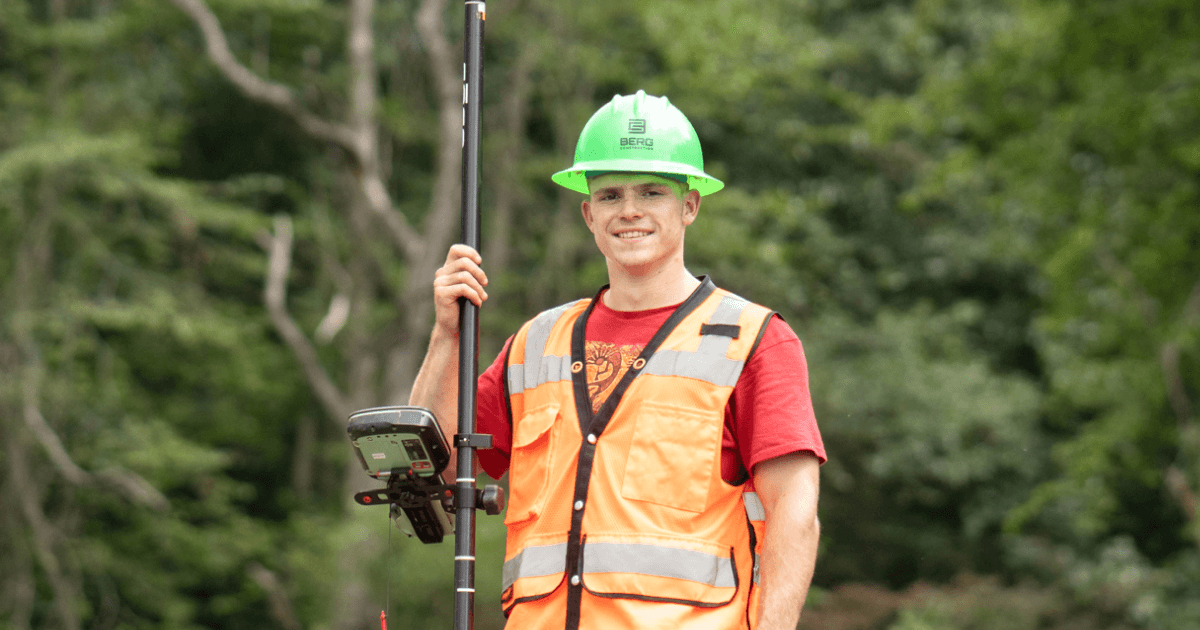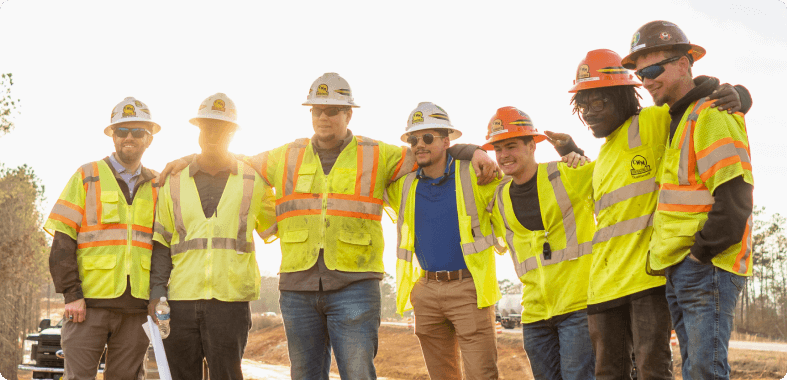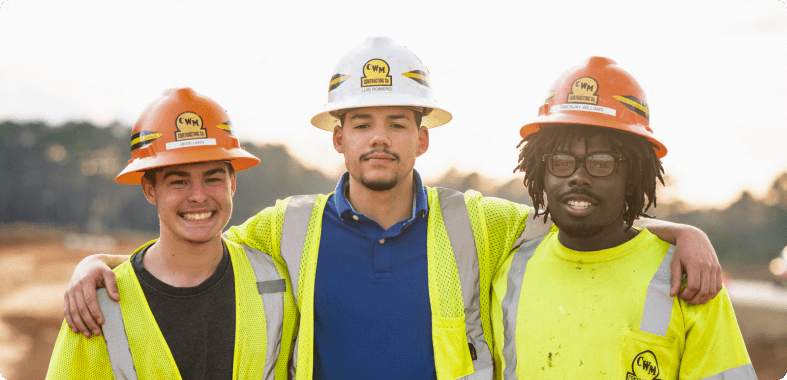16 Myths the Next Generation Believes About the Dirt World
Written by Megan Hamilton
November 23, 2022

Have you ever wondered what’s keeping the next generation out of the Dirt World?
Sure, there are rumors—kids today are lazy, they don’t want to work, they want everything handed to them. For a miniscule percent of the population, that might be true. But what’s keeping most young people out of the Dirt World are the rumors they’ve heard about you.
Buckle up. We’re exploring 16 myths people believe about the Dirt World—and how you can bust those myths to attract the next generation of the workforce.
Lifestyle

Most people think a construction worker’s lifestyle ain’t pretty. They think crew members are underpaid, overworked, and unstable.
Myth #1There’s no money in it.
The most common myth is that the Dirt World underpays people. However, the median wage for construction and extraction workers in 2021 was $2,450 higher than the median salary for all industries.1
Consider the salaries for these Dirt World jobs:
| Role | Median Yearly Salary* |
|---|---|
| Laborers and helpers | $37,7702 |
| Pipelayers | $45,9803 |
| Construction truck drivers | $47,6104 |
| Operators | $48,2905 |
| Electricians | $60,0406 |
| Inspectors | $61,6407 |
| Mining or geological engineers | $97,0908 |
| Heavy civil construction managers | $100,3109 |
*Median salaries reflect people’s earnings more accurately than average salaries. A few high (or low) salaries can make averages look higher (or lower) than they really are, but medians are the true midpoint.
You may have noticed laborers typically earn below the national median salary, but they can quickly move into higher-paying positions if they’re willing to learn.
You can help dispel the money myth by being transparent about compensation. When you post a job opening, include the wages. (Or provide a range if the pay varies.) The more open you are, the more young people can see that they can earn a good living and support a family in this industry.
Myth #2It’s too physically demanding.
Studies show that 78% of children and 77% of adults don’t get enough exercise.10,11 That’s a shame because studies also show active people are happier and more satisfied with life.12,13 Sedentary lifestyles may explain why one-third of people aged 18-34 don’t feel like they contribute to society.14
Young people want to change that. They want fulfilling jobs. And they’ll get even greater satisfaction in the Dirt World, where mission-minded work gets them outdoors and challenges them physically. You'll win them over when you show them that the industry will push them to be the best version of themselves.
Another thing you can do? Teach people that these jobs don’t have to beat up their bodies. Construction and extraction can be physically demanding, so you must educate recruits about staying healthy in this industry.
Myth #3There’s no stability.
Young people want to know the Dirt World is stable, and they don’t think it is.
To some degree, the economy can impact whether construction projects continue or get put on hold. It can impede certain mining fields.
However, this industry is essential. We will always need roads and buildings. We will always need natural resources to make necessities like solar panels or lithium batteries for cars. Excavation, demolition, water drainage, mining, hauling—they will always be there. Even if a particular job goes away, there’s another one around the corner.
Your goal is to help the next generation of workers see that a career in the Dirt World is a career for life.
Myth #4I’ll have to work every weekend.
White-collar workers can be pretty certain that they’ll work Monday through Friday, 9-5 . . . or that they’ll get to choose their hours if their employer offers flex time.
With blue-collar jobs, crew members typically need to work at the same time, so there’s less flexibility. The Dirt World is also known for long shifts. Crew members self-report working 8-14 hours a day.15 They might also work overtime, nights, or weekends for certain projects—like repaving a busy road in the summertime.
Understandably, young people don’t want to work long, weekend, or night shifts when they can have better hours elsewhere.
However, the average construction crew member works 40 hours a week, and typical shifts are often 7 a.m. to 3:30 p.m.16,17 There’s also a big push to create a better work-life balance in the industry. Many companies are giving their employees regular weekends and even flex time.18
Myth #5If I get into construction, I’ll get addicted to alcohol or drugs.
This myth is rooted in a painful truth: addiction is common in the Dirt World. Sadly, 14% of construction workers and 12% of mine workers reported having a substance-use disorder.19 Others struggle with unreported, untreated addictions.
Mining and construction workers are most likely to consume alcohol heavily, compared to workers in other industries.20 And while illicit drug use declined from 2003-2012, heavy alcohol consumption increased.21
Some reasons for that include:
- Loneliness when traveling away from family and friends for work
- Self-medicating work-related injuries22
- Poor mental health due to high-stress, high-risk jobs
Career-building

Young people often job-hop to find better pay, benefits, promotions, or the right career fit.23 Essentially, they’re switching jobs to build a meaningful career. They’re just not sure they can do that in the Dirt World.
Myth #6Construction isn’t a real career.
You’re in this industry. It's a lifelong career with ample opportunities to learn new skills, grow, move up, and lead others.
The work itself can be meaningful and deeply fulfilling. Dirt World workers make the things society needs to survive, and many companies give back through charity projects. For example, Blount Contracting paved a school parking lot at cost; now, community members can see how Blount improved their kids’ lives.
Unfortunately, most people don’t see the Dirt World like that. They think it’s hard, dirty, and unfulfilling. So you have to teach the next generation the truth through exceptional marketing.
Learn everything you need to know about marketing and construction, from how to get started on a budget to how marketing helps with recruiting.
Myth #7There aren’t enough jobs.
Did you laugh out loud at that? Yeah, so did we. We have no idea how this rumor started, but it’s not true. In 2022, the construction industry was short over 650,000 workers.24
There are jobs everywhere; young people just don’t know about them. The solution is to conquer your fears and get on social media. That’s where the next generation hangs out; you can tell them all about jobs in the industry.
Myth #8You need to know somebody to get started.
Honestly, the people who work in the industry haven’t done a very good job telling others how to get there. That’s why most people see the Dirt World as a “generational” career—where you work construction because your dad or grandpa did it first. Or you get hired at a mine because your friend works there.
But the truth is, the Dirt World is open to anyone willing to work hard, be humble, and learn.
How can you help those people get started in the industry? Maybe you create a haul truck driver training program or help them transition from laborer to pipelayer within a certain timeframe. Maybe you do something else.
Will Schuler, owner of Will Power Excavation, sat down with BuildWitt CEO Aaron Witt to talk about hiring inexperienced people and how those young workers are hungry to learn. Check out their conversation.
Myth #9You have to start at the bottom and work your way up.
If somebody is fresh out of high school or has zero experience, then yes, they’ll probably start with a shovel in their hand. And they’ll probably stay that way until the foreman is sure it’s safe to move them up.
That’s tough to swallow, especially for people who already sank time into another career. They may not realize how quickly they can move up in the Dirt World.
You can help by showing recruits clear, well-timed growth tracks at your company. Discuss opportunities for promotion when you onboard new hires. (Onboarding increases loyalty, productivity, and safety, so it’s a must-do.) Knowing when and how they can move up motivates people to take the plunge.
Knowledge

People won’t join the Dirt World if they don’t know it exists, why it matters, or how they can succeed.
Myth #10Somebody else will build things.
Most people don’t look at a road paving crew, pipelaying crew, or dump truck driver and think, Wow, those people are essential. I couldn’t live my life if they didn’t do their jobs!
Think about this: A surgeon can only save lives because Dirt World crew members built the hospital, paved the road to it, mined materials to make scalpels and electricity, and transported those materials where needed.
The Dirt World makes what our society needs to survive. That’s an incredible mission to be part of, and today’s generation wants to be part of a mission. If you want to recruit young people into your company, tell them why your work matters—and why you need them to be part of it.
Myth #11I can’t work in the industry because I don’t know how to build things.
We all want to present ourselves as intelligent, capable people. So asking young people to work with their hands—or do a certain type of handiwork—when they’ve never done that before can be really intimidating for them.
They need to know they’ll get safe, effective on-the-job training. They won’t embarrass themselves if they don’t know how to do something; they will learn and grow with help from good leaders and mentors.
Stereotypes

We already talked about stereotypes of the construction and extraction lifestyle. But there are also stereotypes about workers themselves.
Myth #12It’s just a bunch of grumpy old dudes cursing at each other all day.
Today’s generation is big on kind, respectful workplaces. So, working with grouchy old men who swear and tell filthy jokes isn’t appealing. Young people have an imaginary construction worker in their heads, and they don’t want to work with that guy.
But they do want to work with Ron, the operator, who’s got three grandkids, likes fly fishing, and can teach them the ropes. They want to work with Sandy the project manager, who’s knocking it out of the park leading her crew, drives her kids to softball practice every Tuesday, and has a passion for mentoring.
When you show off the incredible men and women who already work for you, incredible young men and women want to join them.
Myth #13Construction workers are stupid.
Spend two seconds on a jobsite; you know this one’s a whopper.
Construction is just like any other industry: some people have book smarts, some have common sense, and some are emotionally intelligent. You also have workers who struggle in some of these areas—and some who are smart in pretty much every way.
Once people see how much math grade checkers do, how much planning goes into running a jobsite, or how intricate operating an excavator can be, they’ll never think construction workers are dumb again.
Myth #14You need a four-year degree to succeed in life.
The story driving this myth goes like this: “Smart people are successful, and smart people go to college. If you’re smart, you’ll go to college, too.” The implication is that if young people don’t attend college, they’re stupid and will be unsuccessful.
That’s a load of bull, and it’s coming from educators and parents. They’ve bought into the idea of higher education and pushed it to kids because they think it’s what’s best. Yet colleges and universities are full of unhappy, unmotivated young adults who don’t want to be there, who shouldn’t be there, and who are only there because they’re trying to make somebody else happy.
So why do people push college so hard? Because they have misguided perceptions of the Dirt World. Look at this recent poll:
| Perception | Educators | General Public |
|---|---|---|
| Road construction is dirty and labor-intensive. | 55% agree | 47% agree |
| Road construction is dangerous. | 48% agree | 42% agree |
| I would recommend road construction as a career to my student/child/relative. | 51% agree | 40% agree25 |
However, those numbers changed dramatically after seeing positive messaging about road construction. Take a look:
| Perception | Educators | General Public |
|---|---|---|
| Road construction is dirty and labor-intensive. | 38% agree | 38% agree |
| Road construction is dangerous. | 32% agree | 35% agree |
| I would recommend road construction as a career to my student/child/relative. | 70% agree | 60% agree26 |
Negative perceptions went down, while positive perceptions like “provides on-the-job skill training” and “offers a variety of job opportunities increased by 19% for the public and 23% for educators.27
Why is that important? Because most people who are giving today’s generation career advice don’t know the benefits of careers in the Dirt World . . . but they’re willing to learn. You can change the minds of parents, grandparents, teachers, and guidance counselors.
Imagine what would happen if more parents understood that a career in the trades would give their child financial stability.
Imagine if more teachers realized what one Atlanta educator already figured out: “The first time I . . . found out how much money [my plumber] was making, I was like, ‘What am I doing?’ I don’t want to be a plumber, but maybe there were some other jobs that I should have thought about.”
You can bet your boots that an educator is more likely to encourage students into the trades than most other educators. They’ll encourage students to do what’s best for them, not mindlessly pursue a four-year degree.
With that in mind, how can you help educators and community members see why your field is a good career path? How can you teach people why your work matters? How can you help them see the positives, so they’ll be more likely to encourage their kids to work with you?
Personal safety

Today’s generation wants to know you care about their physical safety. If they don’t feel safe, they won’t work for you.
Myth #15The work is too dangerous.
Lately, we’ve talked about types of jobsite safety issues and why you have safety problems onsite. Those articles dive deeper into the subject, so we won't rehash all that information here.
However, we will remind you that young people are right to worry about their personal safety. Construction workers reported 165,300 on-the-job injuries in 2020 (no telling how many went unreported), and 1,008 workers died onsite.28 Those numbers should not be overlooked.
Fortunately, you can help lower them and attract the next generation of workers by training new hires on safety and providing ongoing safety training for every crew member.
Tell recruits upfront that they’ll receive this training, and make sure they know you take safety seriously. When they see that injuries and accidents aren’t the norm at your company, they’ll feel safe working with you.
Myth #16There are too many (or not enough) safety rules.
OSHA and MSHA govern the Dirt World safety protocols—they're organizations meant to help keep workers safe.
Some people worry these federal organizations or potential employers will impose too many safety rules. They fear not having the freedom to do their jobs effectively or creatively.
Other people may not want to work in the Dirt World because they don’t think the rules are enough. OSHA, MSHA, state and local regulators, and employers have all imposed safety rules on top of safety rules—but that doesn’t mean a hill of beans if people don’t follow them.
Many young people have heard rumors that construction companies and mines ignore safety rules, and they don’t want to work for a company that’s doing shady things just to make a buck.
You can do two simple things to allay their concerns: follow the rules and make it clear to recruits that you do this. Some may not be willing to play ball, but those aren’t the people you want to hire anyway. Most recruits will appreciate knowing you value the safeguards in place to protect them.
Conclusion
We hope you have a better idea of what’s really keeping young people out of the workforce. And hopefully, you feel a little better equipped to get out there and bust these myths.
One way you can do that is by joining Better Dirt World. It’s a community of companies and individuals who are banding together to secure the industry’s future by
- Paving pathways into the industry
- Changing the narrative around blue-collar work
- Providing better training to the workers who are already here
- Building a community for the Dirt World
Want to get involved? You can help strengthen the industry and start recruiting the next generation of workers today.














